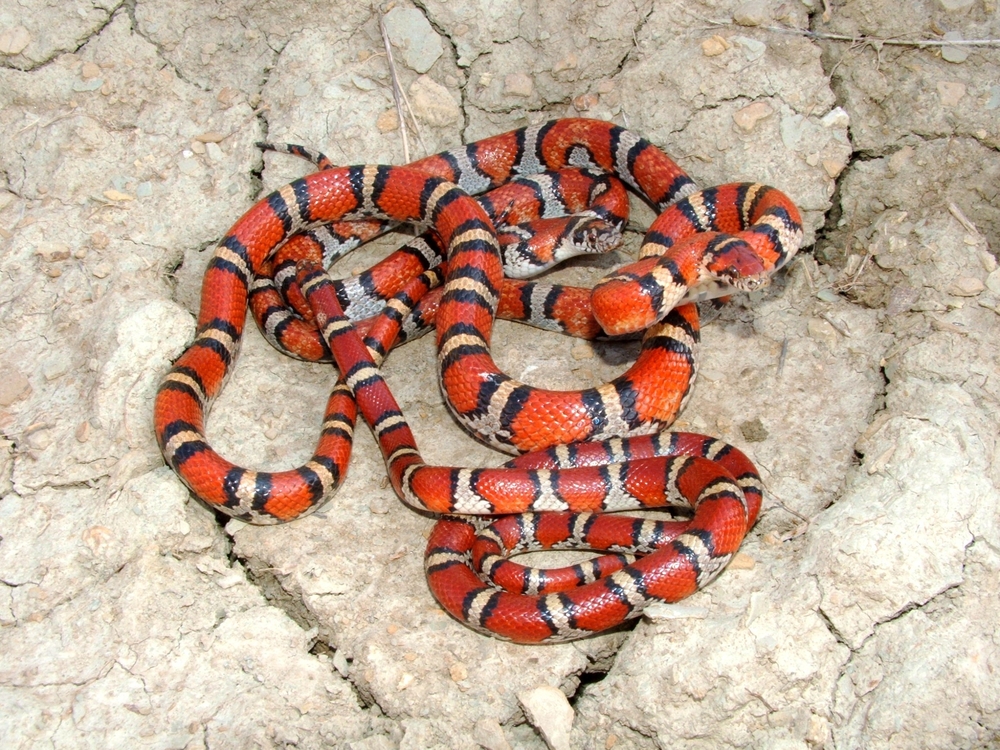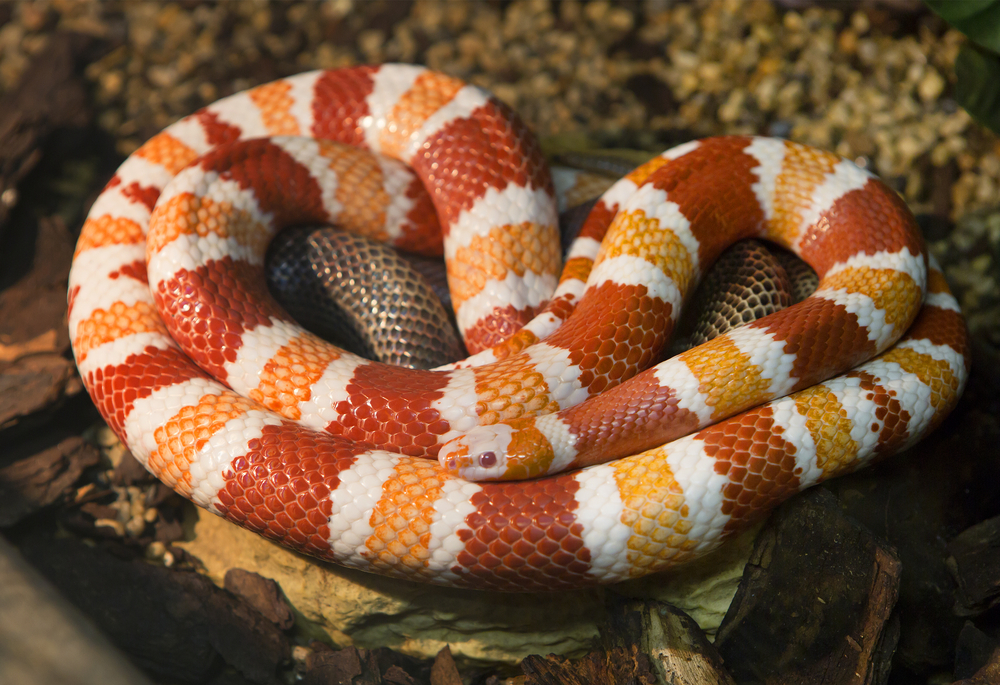Facts About Milk Snakes

Brightly colored and strikingly patterned, milk snakes are nonvenomous New World snakes with a wide range throughout North and South America. They are often confused with dangerous copperheads or coral snakes; however, milk snakes pose no threat to humans. In fact, they are popular pets easily bred in captivity.
They are a species of kingsnake. Milk snakes and kingsnakes belong to the genus Lampropeltis. In Greek, this means "shiny shields," according to Anapsid.org. The name is appropriate for the genus, which is known for its well-defined, glossy scales.
According to Bill Heyborne, a herpetologist and professor of biology at Southern Utah University, there are 24 recognized subspecies of milk snakes (Lampropeltis triangulum). "Some scientists have suggested that they should actually be split into multiple species," he said.
The scarlet kingsnake was categorized as a subspecies of milk snake until 2006, when scientists determined that it was a separate species, according to the Virginia Herpetological Society.
Milk snakes get their name from a folktale that describes a snake sneaking into a barn and drinking the milk from nursing cows, according to University of Michigan's Animal Diversity Web (ADW). This tale has no bearing in reality and is scientifically impossible because snakes do not have lips and could not hold that much milk.
Appearance
The appearance and coloration of milk snakes varies somewhat among the 24 subspecies, but all have banded coloration, said Heyborne. "These bands can vary in color from white to red to black, and alternating bands of differing colors are common," he said. The lighter area separating the colorful bands can be white, yellow or orange. The darker bands are outlined in black. Many milk snakes have a light-colored Y or V shape on their necks.
Milk snakes range from 14 to 69 inches (35.5 to 175 centimeters) long, according to ADW. The longest snakes are found in Central and South America. Milk snakes in the United States and Canada don't grow beyond 51 inches (129 cm). Milk snakes have between 19 and 23 rows of scales, which are smooth. They have one anal plate. Milk snakes are sexually alike, meaning that males and females grow to the same length and have the same coloration and patterns.
Get the world’s most fascinating discoveries delivered straight to your inbox.
Like many nonvenomous snakes, milk snakes have round pupils, according to PA Herps.com.
Confusion with venomous snakes
"Milk snakes are well known for their use of mimicry as a defensive strategy," Heyborne said. They are often confused with copperheads and coral snakes because they all have bright, blotchy coloration. Nonvenomous milk snakes evolved to look like these venomous species in order to scare predators. "This type of mimicry, where a harmless species mimics a harmful species, is known as Batesian mimicry," said Heyborne. It can be an effective defensive strategy, but has caused milk snakes other problems. Humans often kill harmless milk snakes, thinking they're dangerous.
According to the Savannah River Ecology Laboratory, one easy way to tell milk snakes from copperheads is by paying attention to the shape of their blotches. Milk snakes' bands are rounded and thick, while copperheads' splotches have a distinctive hourglass shape.
Some milk snakes' coloration is similar to the dangerous coral snake. "Many subspecies of milk snakes overlap the venomous coral snake in range," Heyborne said. "Coral snakes also have alternating bands of color, but the patterning differs between the two snakes. Coral snakes have red and yellow bands next to one another, while the harmless milk snake has red and black bands next to each other.
In areas of the world where both species exist, there are a variety of rhymes, which have been used to help people distinguish the two. For example, "Red on yellow kills a fellow. Red on black, friend of Jack."
Milk snakes sometimes try to trick predators into thinking they're rattlesnakes by shaking their tails. Again, this can cause problems when humans think they're looking at a dangerous rattler. But rattlesnakes and milk snakes don't look much alike; rattlesnakes are duller colored and thicker than milk snakes.
Where milk snakes live
Milk snakes have a wider geographic range than most snakes and have the biggest range of any snake in North America. According to Western Connecticut State University, they can be found as far north as Ontario and Quebec and as far south as Venezuela. They live throughout Mexico and Central America. In the United States, they can be found almost everywhere but the West Coast.
Given their broad range, milk snakes must be able to thrive in a variety of habitats. They most commonly like forested places but are also happy in fields, rocky outcroppings, agricultural areas and barns, according to the Savannah River Ecology Laboratory. They like to spend much of the day under rocks, boards or hidden in dark places of barns. Contrary to their namesake folktale, milk snakes do not frequent barns to "milk" the cows; instead, they seek out the rodents living there.
Behavior
Milk snakes are generally solitary and primarily nocturnal, being most active at night and dusk. When it is wet or cool outside, they sometimes venture out during the day, according to Montana Outdoors magazine. On hot days, milk snakes usually stay under rocks, logs or in burrows.
Milk snakes spend the winter in a state of brumation in communal dens. Brumation is like hibernation but the animal wakes to drink water. The dens might be in burrows or in rock crevices. Sometimes other snakes, including rattlesnakes, stay there, too, according to ADW.
Hunting and diet
Milk snakes are carnivores that eat a wide variety of prey, including mammals and birds, said Heyborne. Common prey includes mice, rats, voles and other rodents found in agricultural areas, as well as lizards, snakes and snake eggs and bird eggs. Sometimes they even eat their lookalikes, the dangerous coral snakes.
"Milk snakes are powerful constrictors," said Heyborne. They wrap their bodies tightly around their prey until its heart stops from lack of blood flow. Once the prey is dead, the milk snake swallows it whole.
Reproduction and lifespan
Milk snakes mate from approximately March to May, depending on the subspecies. They breed when they wake from brumation, though according to the University of Michigan, they sometimes mate while still in their winter dens. If outside the den, the female leaves a pheromone trail behind her once she begins to ovulate. The males follow her trail.
Milk snakes will sometimes copulate for hours, according to Western Connecticut State University. This may be to prevent other males from mating with an ovulating female.
Milk snakes are oviparous, meaning that the mother lays eggs. She'll lay between two and 17 eggs about 30 days after copulation. Milk snakes often lay eggs in rotting logs, beneath rocks or buried in soil, according to the Virginia Herpetological Society. A warm, humid place is important for proper incubation, which can last for one or two months. Once the eggs are laid, there is no further parental involvement.
Hatchlings range from 6 to 7 inches and have bright coloration that dulls somewhat as they mature. Juveniles typically eat invertebrates before graduating to mammals and birds, said Heyborne.
Milk snakes reach full maturity between 3 and 4 years of age. Their lifespan in the wild is unknown but in captivity they have lived as long as 22 years, according to ADW.
Endangerment status
Milk snakes are not federally protected or on the Red List (threatened list) of the International Union for Conservation of Nature (IUCN). They are locally protected in some states, however, such as Georgia and Montana where they are listed as a "species of concern."
Taxonomy/classification
The taxonomy of milk snakes, according to the Integrated Taxonomic Information System (ITIS), is:
- Kingdom: Animalia
- Subkingdom: Bilateria
- Infrakingdom: Deuterostomia
- Phylum: Chordata
- Subphylum: Vertebrata
- Infraphylum: Gnathostomata
- Superclass: Tetrapoda
- Class: Reptilia
- Order: Squamata
- Suborder: Serpentes
- Infraorder: Alethinophidia
- Family: Colubridae
- Genus: Lampropeltis
- Species: Lampropeltis triangulum
Select subspecies
Here are a few popular subspecies of milk snake:
Eastern milk snake
Probably the most well known milk snake, the eastern milk snake (Lampropeltis triangulum triangulum), is common throughout the much of the Northeastern United States. It ranges from Maine to Minnesota and Iowa, and as far south as northern Georgia, according to the Ohio Public Library Information Network.
The Eastern milk snake is slender with reddish-brown blotchy bands rimmed in black on a tan or gray background. The belly has a black-on-white checkerboard look, according to the Savannah River Ecology Laboratory. They grow to about 4 feet (1.2 meters) long. Eastern milk snakes are commonly confused with copperheads but their blotches are quite different shapes.
Honduran milk snake
In the wild, Honduran milk snakes (Lampropeltis triangulum hondurensis) are bright reddish orange with black stripes. Between the black stripes is a narrow band of either white/yellow (called the tri-color morph) or a lighter orange (called the tangerine morph). Tri-color morphs have bands that extend around the belly and tangerine morphs have bands that extend down the sides. Honduran milk snakes are popular pets and other color morphs have been bred in captivity, according to Western Connecticut State University.
Honduran milk snakes are found in Honduras, the Southwestern United States, Nicaragua and Costa Rica, according to the Pittsburgh Zoo. They grow to about 4 feet long.
Pueblan milk snake
According to the American Museum of Natural History, Pueblan milk snakes (Lampropeltis triangulum campbelli) are commonly confused with coral snakes. Their band pattern is red, black, white, black, red. Coral snakes have yellow bands next to the red ones.
Pueblan milk snakes' red bands are about twice as wide as the black and white bands. Other color morphs have been bred in captivity, according to Wildlife North America. Pueblan milk snakes are popular pets. They are relatively small, growing to about 2.5 feet (76 cm), according to the University of Pittsburgh.
Pueblan milk snakes are sometimes called Campbell's milk snakes. They are called "Pueblan" because they are native to Puebla, Morelos and Oaxaca, Mexico, according to the American Museum of Natural History.
Red milk snakes
Red milk snakes are often confused with coral snakes, according to the Missouri Department of Conservation. They have a white, yellow or tan body with reddish banded blotches rimmed in black, meaning the "red touch black, friend of Jack," part of the rhyme is accurate.
Red milk snakes are relatively small, averaging between 21 and 28 inches (53 to 71 cm). They can be aggressive when threatened, according to Wildlife North America, but are still sometimes kept as pets. Like all milk snakes, they are nonvenomous and not dangerous to humans.
Red milk snakes are found in parts of the American South and Midwest, including Kansas, Missouri, southern Illinois, southwest Indiana, Kentucky, Iowa, north Arkansas and west Tennessee.
Additional resources
Jessie Szalay is a contributing writer to FSR Magazine. Prior to writing for Live Science, she was an editor at Living Social. She holds an MFA in nonfiction writing from George Mason University and a bachelor's degree in sociology from Kenyon College.



